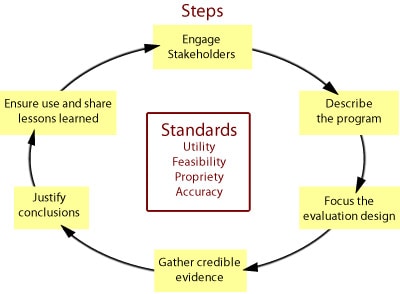At a glance
Measures and outcomes are part of an evaluation process. It is important to know and understand why you want to measure and what you intend to do with the results before you begin. Here you will find a description of CDC's Framework for Program Evaluation, and possible sources of communication and health literacy measures.
CDC's framework for program evaluation
A strong evaluation approach ensures that the following questions will be addressed as part of the evaluation so that the value of program efforts can be determined and judgments about value can be made on the basis of evidence:
- What will be evaluated? (i.e., what is "the program" and in what context does it exist?)
- What aspects of the program will be considered when judging program performance?
- What standards (i.e., type or level of performance) must be reached for the program to be considered successful?
- What evidence will be used to indicate how the program has performed?
- What conclusions regarding program performance are justified by comparing the available evidence to the selected standards?
- How will the lessons learned from the inquiry be used to improve public health effectiveness?
Begin by identifying the communication and health literacy programs or activities in your organization and the context for these.
- Is communication a valued or undervalued area? Visible or invisible?
- Which programs and activities not explicitly labeled communication or health literacy include these elements?
- What do you already measure about communication?
- What types of systems do you have for collecting, analyzing, and reporting communication data?
- Who can reliably collect and report data for you?

Possible sources of communication and health literacy measures
- Healthy People 2020
- Health communication and health information technology progress measures.
- Health communication and health information technology progress measures.
- National Action Plan to Improve Health Literacy
- Goals and strategies that can be translated into measures
- Goals and strategies that can be translated into measures
- National Standards on Culturally and Linguistically Appropriate Services
- Standards that can be translated into measures
- Standards that can be translated into measures
- Federal Plain Language Guidelines
- Attributes of a health literate healthcare organization
- Organizational characteristics that can be translated into measures
- Example: Proportion of clinicians with patient contact trained to use the teach-back method; audited for their use of teach-back; and whose patients report use of teach-back
- Organizational characteristics that can be translated into measures
- Core measures from National Academy of Medicine Roundtable on Value & Science-Driven Health Care
- Example: patient-centered measures about patient knowledge and understanding of care plan
- Example: coordination and communication measures about communication among healthcare team members, including the patient
- Example: patient-centered measures about patient knowledge and understanding of care plan
- Consumer Assessment of Healthcare Providers and Systems (CAHPS)
- Example: patient questions about their experience, including providers' communication skills
- Example: specific health literacy provider module
- Example: patient questions about their experience, including providers' communication skills
- The Joint Commission Accreditation Standards
- Example: 2010 Roadmap
- Example: 2010 Roadmap
- Environmental assessments
- Example: partnering with community to walk your facilities and see it through their eyes
- Example: partnering with community to walk your facilities and see it through their eyes
- Individual organization's satisfaction and experience surveys and qualitative assessments
- CDC Clear Communication Index
- Training evaluations
